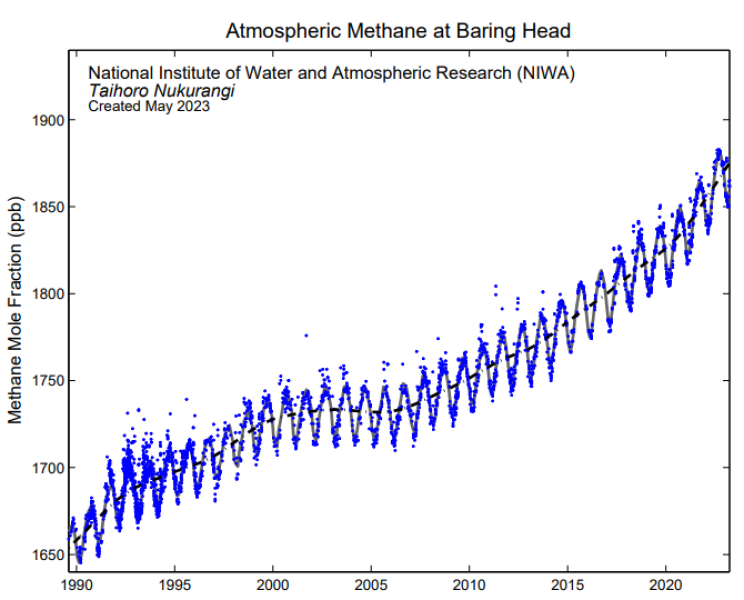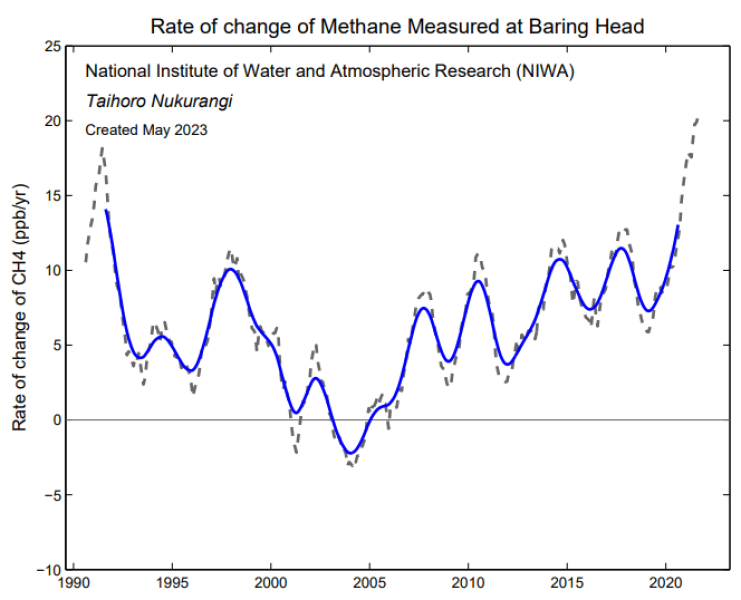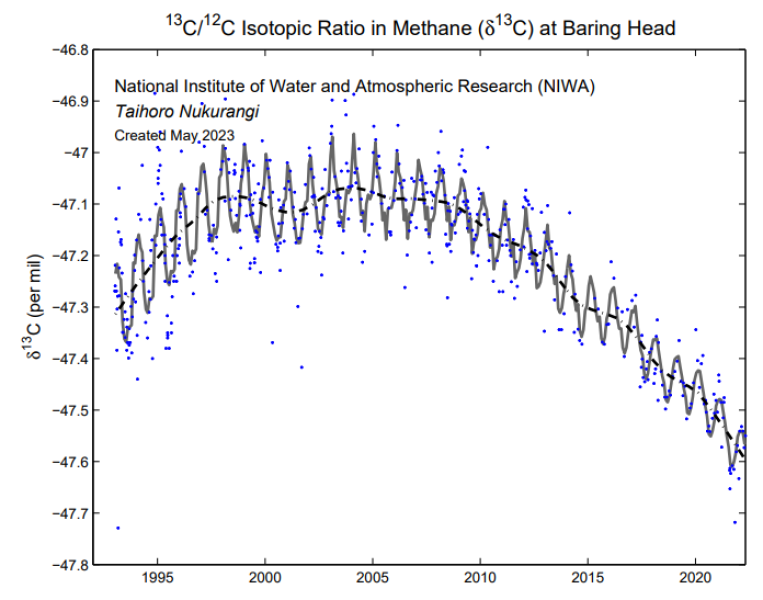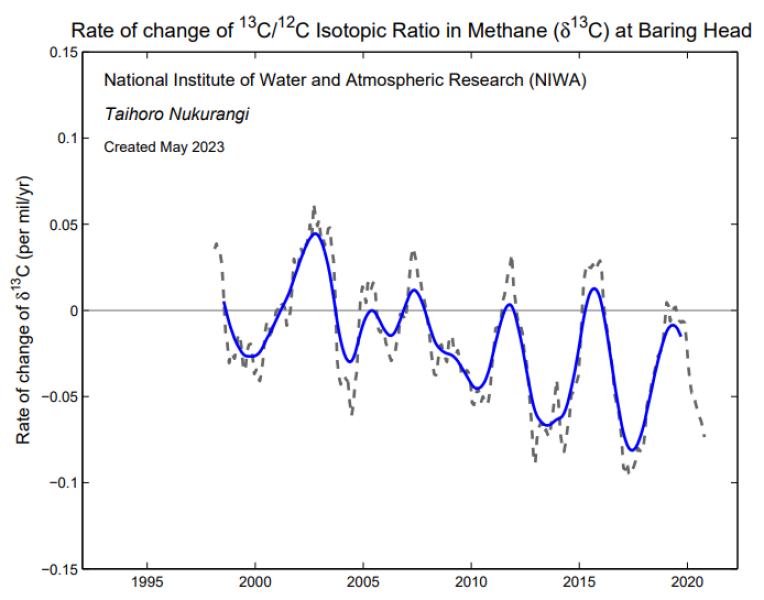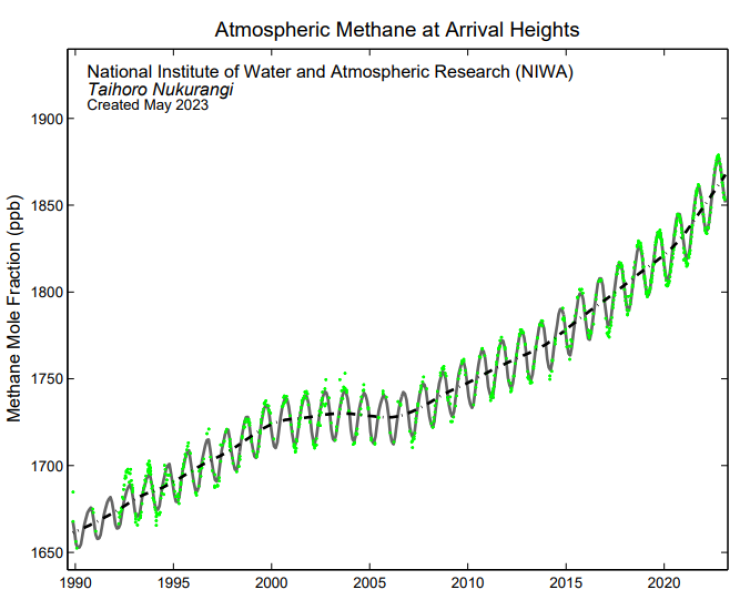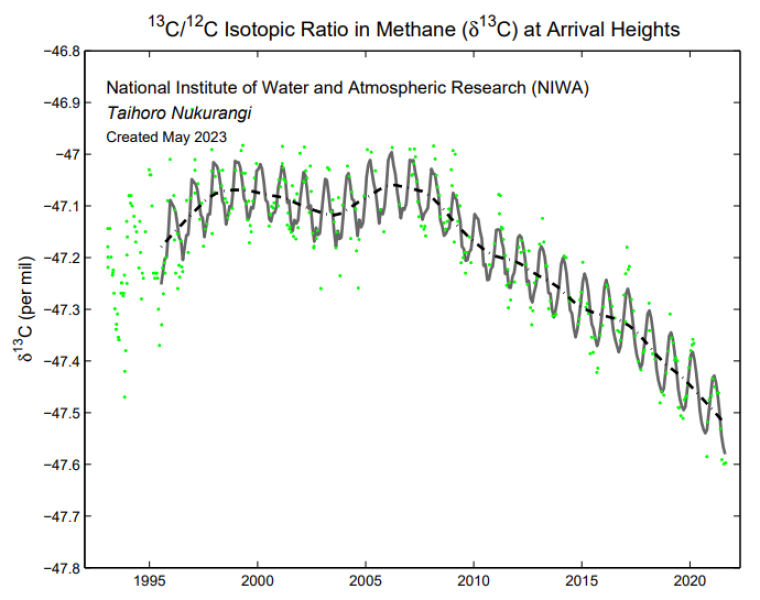Methane (CH4) is the second most important greenhouse gas after CO2 that is produced by human activities.
While most of the anthropogenic emissions of CO2 are from industrial processes, such as fossil fuel burning and cement production, most anthropogenic CH4 emissions are from agriculture (e.g. grazing animals such as cows and sheep, manure management, biomass burning and rice agriculture). As a result, CH4 is a particularly important greenhouse gas for New Zealand. CH4 also has a substantial impact on atmospheric chemistry and air quality, because it is removed from the atmosphere by reaction with the hydroxyl radical (OH), which in turn destroys the OH. The higher abundance of OH in the summer causes the seasonal cycle seen in the CH4 concentration record. For more information on OH, see carbon monoxide.
Baring Head measurements of CH4 began 1989/90. The CH4 concentration rose until the early 2000s, then stabilised for several years before resuming an upwards trend in about 2007. Individual flask measurements of CH4 at Baring Head (blue diamonds) have been fitted with a smoothed curve (gray line) using Seasonal Decomposition of Timeseries by Loess (STL). The black line shows the smoothed curve with the seasonal cycle removed.
The growth rate of CH4 in the atmosphere calculated from monthly mean data that has had the seasonal cycle removed (gray dashed line). The blue line shows the growth rate after it has been smoothed with a 12 month running mean.
d13C in CH4
13C is a stable isotope of carbon (with one additional neutron compared to most carbon atoms). Many natural processes that produce or destroy CH4 influence the isotopic composition of atmospheric CH4. The isotopic signatures of the sources allow scientists to use the 13C/12C isotopic ratio of CH4 to understand what processes are driving changes in the atmospheric methane. This data set provides a window into the role of wetlands, fires, and atmospheric chemistry and transport in atmospheric methane.
The 13C/12C isotope ratio in CH4 is shown as the relative difference from the VPDB* standard in permil (‰). Individual flask measurements of CH4 at Baring Head (blue diamonds) have been fitted with a smoothed curve (gray line) using Seasonal Decomposition of Timeseries by Loess (STL). The black line shows the smoothed curve with the seasonal cycle removed.
*VPDB = Vienna- PeeDee Belemnite standard, a standard originally obtained from a Cretaceous marine fossil, Belemnitella americana, from the PeeDee Formation in South Carolina. This material has a higher 13C/12C ratio than nearly all other natural carbon-based substances. For convenience it is assigned a delta 13C value of zero, giving almost all other naturally-occurring samples a negative delta value. The original sample was used up long ago, but a Vienna-based laboratory calibrated a new reference sample to the original fossil, giving rise to the widespread use of the term Vienna- PeeDee Belemnite standard, abbreviated to V-PDB.
The relative change of 13C /12C in atmospheric CH4 calculated from monthly mean data that has had the seasonal cycle removed is shown by the gray dashed line. The blue line shows the growth rate after it has been smoothed with a 12 month running mean.
Arrival Heights
A secondary monitoring station is located at Arrival Heights, Antarctica. Similar trace gas measurements to Baring Head have been performed here though less frequently due to the logistical challenges in Antarctica.
Arrival Heights measurements of CH4 began 1989/90. The CH4 concentration rose until the early 2000s, then stabilised for several years before resuming an upwards trend in about 2007. Individual flask measurements of CH4 at Arrival Heights (green diamonds) have been fitted with a smoothed curve (gray line) using Seasonal Decomposition of Timeseries by Loess (STL). The black line shows the smoothed curve with the seasonal cycle removed.
The 13C/12C isotope ratio in CH4 is shown as the relative difference from the VPDB* standard in permil (‰). Individual flask measurements of CH4 at Arrival Heights (green diamonds) have been fitted with a smoothed curve (gray line) using Seasonal Decomposition of Timeseries by Loess (STL). The black line shows the smoothed curve with the seasonal cycle removed.
Lauder
Methane has also been measured at NIWA's atmospheric research station at Lauder, in Central Otago, since 2007.

